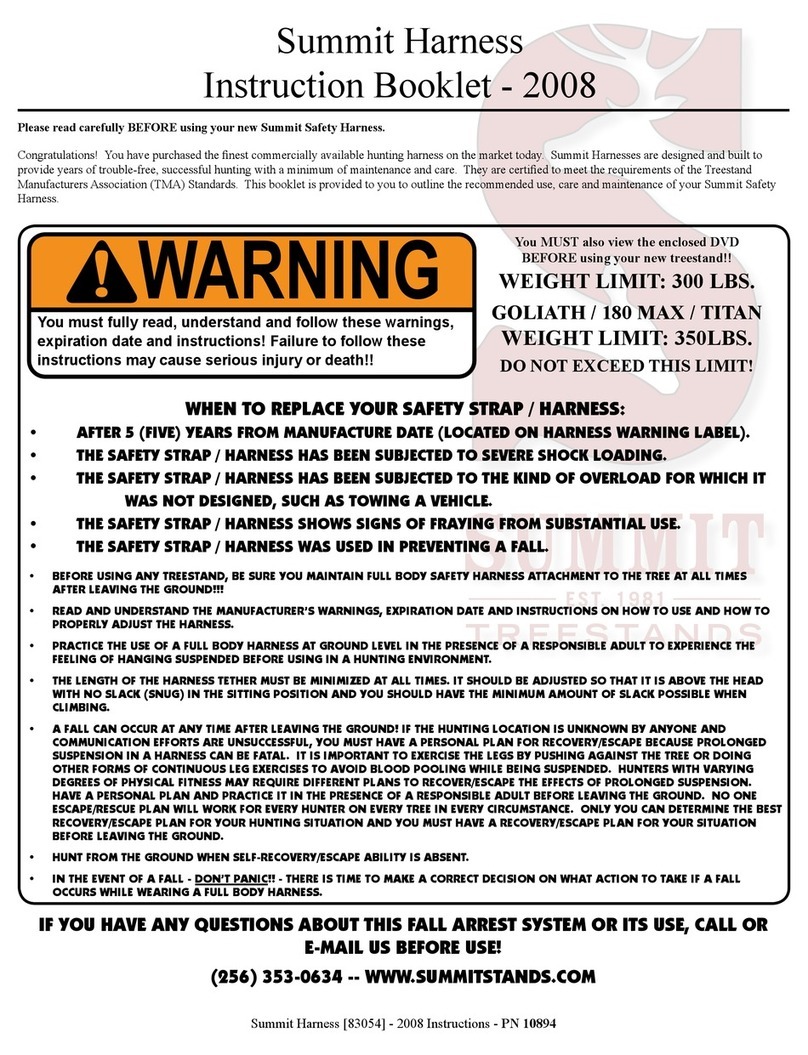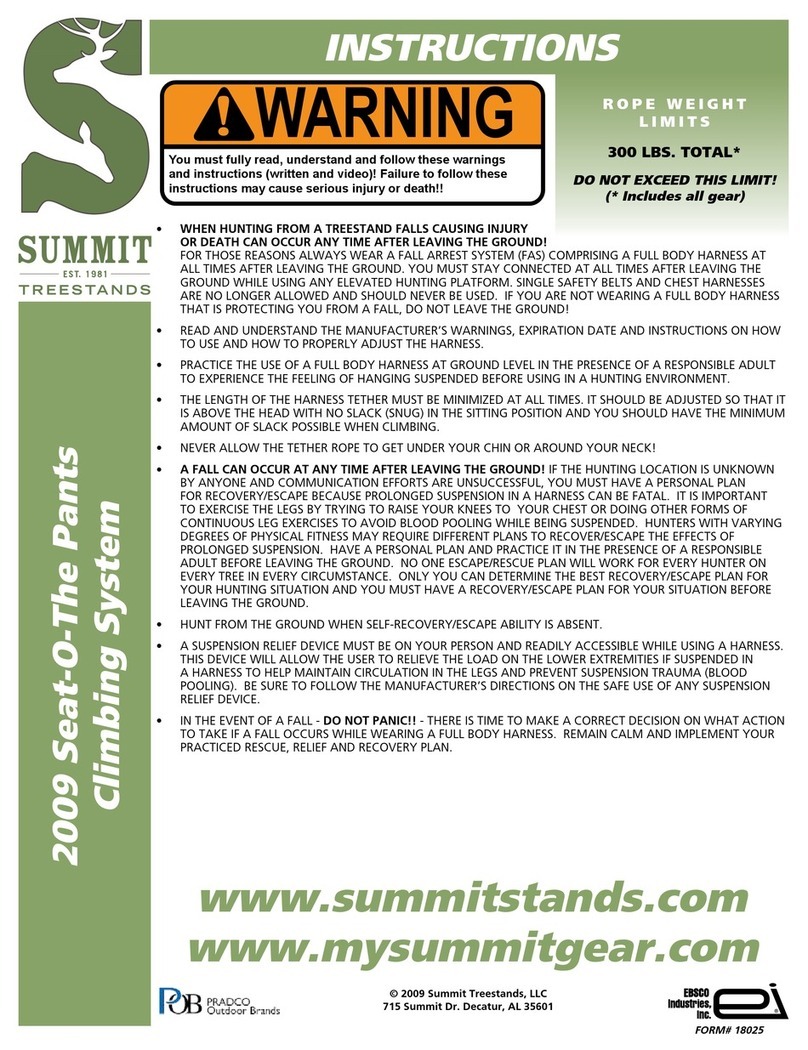
!
NE PAS LIRE ET NE PAS SUIVRE LES AVERTISSEMENTS ET
LES INSTRUCTIONS DU MANUFACTURIER CONSTITUE UNE
MAUVAISE UTILISATION DU PRODUIT ET PEUT ENTRAÎNER
DE SÉRIEUSES BLESSURES OU LA MORT!!
AVERTISSEMENT
FHARNAIS DE CORPS COMPLET AVEC
SYSTÈME D’ARRÊT DE CHUTE (HCCSAC)
SU18195-A & SU18195-B
© 2016 Summit Treestands, LLC | 715 Summit Dr. Decatur, AL 35601
PH#: (800) 353-0634 | www.summitstands.com
POIDS MAXIMUM:
159 KG
UTILISÉ AVEC TOUS LES MODÈLES SUM-
MIT MIRADOR ET PRODUITS SEULE-
MENT!
N’EXCÉDEZ JAMAIS LA LIMITE DE POIDS
MAXIMALE. CECI INCLUS L’UTILISATEUR
AINSI QUE TOUT L’ÉQUIPEMENT TRANS-
PORTÉ SUR LE MIRADOR.
• LISEZ, SUIVEZ ET COMPRENEZ TOUS LES AVERTISSEMENTS ET TOUTES LES INSTRUCTIONS AVANT L’UTILISATION. VÉRIFIEZ TOUTES LES DATES D’EXPIRATIONS SUR LES
ÉTIQUETTES AVANT CHAQUE UTILISATION. SI VOUS NE COMPRENEZ PAS ENTIÈREMENT L’UTILISATION SÉCURITAIRE ET CORRECTE DU HARNAIS DE CORPS COMPLET
AVEC SYSTÈME D’ARRÊT DE CHUTE (HCCSAC) OU DU MIRADOR, CHASSEZ À PARTIR DU SOL! NE PAS SUIVRE TOUS LES AVERTISSEMENTS ET TOUTES LES INSTRUCTIONS
INDIQUÉS PEUT ENTRAÎNER DE SÉRIEUSES BLESSURES OU LA MORT! IL EST REQUIS DE SURVEILLER ET COMPRENDRE LE DVD FOURNI AVEC CE PRODUIT AINSI QUE LES
AVERTISSEMENTS DE SÉCURITÉ ET LES INSTRUCTIONS AU : www.summitstands.com/safety-videos
• VOUS DEVEZ TOUJOURS VÉRIFIER LE MIRADOR ET LE HCCSAC POUR TOUT DOMMAGE OU USURE AVANT CHAQUE UTILISATION! SI VOUS REMARQUEZ DES DOMMAGES OU
DE L’USURE OU SI L’ÉTIQUETTE INDIQUE UNE DATE D’EXPIRATION EXPIRÉE, ARRÊTEZ L’UTILISATION IMMÉDIATEMENT ET CHASSEZ À PARTIR DU SOL.
• PORTEZ TOUJOURS UN HCCSAC QUI RÉPOND RIGOUREUSEMENTAUX STRANDARDS DE L’INDUSTRIE TELS QUE RECONNUS PAR LE TMA. PORTEZ UN HCCSAC À TOUTES
LES FOIS QUE VOUS QUITTEZ LE SOL, EN MONTANT ET EN DESCENDANT. LES COURROIES À UNE BRETELLE ET LES HARNAIS POUR LE TORSE NE SONT PLUS PERMIS ET
NE DEVRAIENT PAS ÊTRE UTILISÉ! NE PAS UTILISÉ UN HCCSAC PEUT ENTRAÎNER DE SÉRIEUSES BLESSURES OU LA MORT!
• LA LONGUEUR DE LA COURROIE D’ANCRAGE DU HARNAIS DEVRAIT ÊTRE RÉDUITE AU MINIMUM EN TOUT TEMPS. ELLE DEVRAIT ÊTRE AJUSTÉE POUR QU’ELLE SOIT
AU DESSUS DE LA TÊTE SANS EXCÉDENT DANS LA POSITION ASSISE ET UN MINIMUM DE JEU DEVRAIT ÊTRE DISPONIBLE LORS DE L’ASCENSION. NE PAS SUIVRE CES
INSTRUCTIONS POURRAIT ENGENDRER UNE SUSPENSION SANS POSSIBILITÉ DE RÉCUPÉRATION VERS LE MIRADOR. SOYEZ VIGILANT EN CE QUI A TRAIT AUX RISQUES
RELIÉS À UNE SUSPENSION DANS UN HCCSAC ET AU FAIT QU’UNE SUSPENSION PROLONGÉE DANS UN HARNAIS PEUT ÊTRE MORTELLE.
• VEUILLEZ TOUJOURS INFORMER UNE TIERCE PERSONNE DE VOTRE EMPLACEMENT DE CHASSE EN CAS D’URGENCE. SI PERSONNE N’EST AU COURANT DE VOTRE
EMPLACEMENT DE CHASSE ET QUE LA COMMUNICATION EST INFRUCTUEUSE, VOUS DEVEZ AVOIR UN PLAN PERSONNEL POUR RÉCUPÉRER OU VOUS LIBÉRER AVANT
L’ASCENSION DANS L’ARBRE. UNE SUSPENSION PROLONGÉE DANS UN HARNAIS PEUT ÊTRE MORTELLE. IL EST IMPORTANT DE FAIRE DES EXERCICES AVEC LES JAMBES
EN POUSSANT SUR L’ARBRE OU EN FAISANT D’AUTRES GENRES D’EXERCICES AVEC LES JAMBES POUR ÉVITER L’ACCUMULATION DE SANG LORS D’UNE SUSPENSION. LES
CHASSEURS POSSÉDANT DES CONDITIONS PHYSIQUES DIFFÉRENTES AURONT BESOIN DE PLANS DIFFÉRENTS POUR RÉCUPÉRER OU SE LIBÉRER ET AINSI ÉVITER LES
EFFETS D’UNE SUSPENSION PROLONGÉE. AYEZ UN PLAN PERSONNEL ET PRATIQUEZ-LE EN PRÉSENCE D’UN ADULTE RESPONSABLE AVANT DE QUITTER LE SOL. AUCUN
PLAN DE RÉCUPÉRATION OU DE LIBÉRATION NE PEUT FONCTIONNER POUR TOUS LES CHASSEURS, POUR TOUT TYPE D’ARBRE ET DANS TOUTES LES CIRCONSTANCES.
SEUL VOUS POUVEZ DÉTERMINER LE MEILLEUR PLAN POUR VOTRE SITUATION ET VOUS DEVEZ AVOIR CE PLAN AVANT DE QUITTER LE SOL. CHASSEZ À PARTIR DU SOL SI
VOUS N’AVEZ PAS LA POSSIBILITÉ DE RÉCUPÉRER OU DE VOUS LIBÉRER D’UNE SUSPENSION.
• PRATIQUEZ L’UTILISATION D’UN HCCSAC AU NIVEAU DU SOL EN PRÉSENCE D’UN ADULTE RESPONSABLE POUR EN COMPRENDRE SON ULISATION CORRECTE ET POUR
EXPÉRIMENTER LA SENSATION D’ÊTRE SUSPENDU AVANT L’UTILISATION DANS UN ENVIRONNEMENT DE CHASSE.
• SI VOUS AVEZ DES QUESTIONS OU DES INQUIÉTUDES QUANT AUX INSTRUCTIONS, AVERTISSEMENTS OU L’UTILISATION CORRECTE “ARRÊTEZ” ET CONTACTEZ LE
MANUFACTURIER. N’UTILISEZ PAS CE PRODUIT JUSQU’À CE QUE VOUS COMPRENIEZ ENTIÈREMENT SON UTILISATION SÉCURITAIRE ET CORRECTE. GARDEZ TOUS LES
AVERTISSEMENTS, INSTRUCTIONS ET DVD POUR UNE UTILISATION ULTÉRIEURE SI NÉCESSAIRE, POUR TOUTE PERSONNE QUI EMPRUNTRERA VOTRE MIRADOR/HCCSAC
OU POUR TRANSMETTRE À QUICONQUE ACHETERAIT CES PRODUITS. UTILISEZ TOUS LES DISPOSITIFS DE SÉCURITÉ FOURNIS AVEC LE MIRADOR ET LE HCCSAC.
• VOUS DEVEZ PORTER UN DISPOSITIF D’AIDE À LA SUSPENSION EN TOUT TEMPS LORS DE L’UTILISATION DU HARNAIS. CE DISPOSITIF PERMET À L’UTILISATEUR DE
SOULAGER LE POIDS QUI PÈSE SUR LES MEMBRES INFÉRIEURS LORS D’UNE SUSPENSION DANS LE HARNAIS CE QUI AIDERA À LA CIRCULATION DU SANG DANS LES
JAMBES ET ALLÈGERA LE TRAUMA DÛ À LA SUSPENSION (ACCUMULATION DE SANG) OU PERMETTRA LA DESCENTE VERS LE SOL. ASSUREZ-VOUS DE SUIVRE LES
INSTRUCTIONS DU MANUFACTURIER QUANT À L’UTILISATION SÉCURITAIRE D’UN DISPOSITIF D’AIDE À LA SUSPENSION.
• PLUSIEURS PRODUITS/SYSTÈMES OPTIONELS QUI SERVENT À L’AUTO-RÉCUPÉRATION OU À L’AUTO-EXTRACTION LORS D’UNE CHUTE LORSQUE SUSPENDU DANS UN
HARNAIS SONT DISPONIBLES. DES SYSTÈMES DESCENDENT AUTOMATIQUEMENT L’UTILISATEUR TANDIS QUE D’AUTRES PERMETTENT LE CONTRÔLE PAR L’UTILISATEUR.
UN DE CES PRODUITS/SYSTÈMES POURRAIT ÊTRE CONDIDÉRÉ À TITRE DE PRÉCAUTION ADDITIONNELLE POUR PRÉVENIR UNE SUSPENSION PROLONGÉE OU UN
TRAUMATISME LIÉ À UNE SUSPENSION. ASSUREZ-VOUS DE SUIVRE LES INSTRUCTIONS DU MANUFACTURIER SUR L’UTILISATION SÉCURITAIRE DE CES PRODUITS/
SYSTÈMES.
• SI UNE CHUTE SURVIENT LORSQUE VOUS PORTEZ LE HCCSAC, PRENEZ LE TEMPS DE PRENDRE LA BONNE DÉCISION EN CE QUI A TRAIT À L’ACTION REQUISE. IL EST
IMPORTANT DE SE SOUVENIR DE “NE PAS PANIQUER”. RESTEZ CALME ET METTEZ EN OEUVRE VOTRE PLAN DE SAUVETAGE, DE SECOURS ET DE RÉCUPÉRATION TEL QUE
PRATIQUÉ.
• N’UTILISEZ JAMAIS LE HCCSAC OU LE MIRADOR SI VOUS ÊTES MALADE, SI VOUS AVEZ DES NAUSÉES OU SI VOUS ÊTES ÉTOURDI, OU SI VOUS AVEZ UNE CONDITION
MÉDICALE QUI POURRAIT POSER PROBLÈME PAR EXEMPLE UNE MALADIE DU COEUR, DES ARTICULATIONS QUI BLOQUENT, DES VERTÈBRES QUI SE FUSIONNENT ETC OU
SI VOUS ÊTES FATIGUÉ.
• N’UTILISEZ PAS LE HCCSAC OU LE MIRADOR SI VOUS ÊTES SOUS L’INFLUENCE DE L’ALCOOL OU DE DROGUES (INCLUANT UNE PRESCRIPTION). CECI INCLU LES
MÉDICAMENTS ACHETÉS AU COMPTOIR QUI POURRAIENT ALTÉRER VOTRE JUGEMENT, VOTRE ÉTAT MENTAL OU VOTRE BIEN-ÊTRE. CONSULTEZ VOTRE MÉDECIN AVANT
L’UTILISATION DU PRODUIT POUR VOUS ASSURER DE L’UTILISATION SÉCURITAIRE ET CORRECTE.
• N’UTILISEZ JAMAIS UN MIRADOR OU UN HCCSAC PAR MAUVAIS TEMPS, PAR EXEMPLE S’IL PLEUT, S’IL Y A DES ÉCLAIRS, UNE TEMPÊTE DE VENT, DE LA NEIGE, DE LA GRÊLE,
DE LA NEIGE FONDUE OU DES CONDITIONS GLACÉES. TERMINEZ VOTRE CHASSE ET DESCENDEZ AU SOL SI CES CONDITIONS SE PRÉSENTENT.
• N’UTILISEZ JAMAIS UN ARBRE MORT, UN ARBRE PENCHÉ OU MALADE OU UN ARBRE AVEC UNE ÉCORCE QUI SE DÉTACHE, OU UN POTEAU D’UTILITÉ PUBLIQUE.
• AYEZ TOUJOURS TROIS (3) POINTS DE CONTACT LORSQUE VOUS GRIMPEZ DANS UN MIRADOR À ÉCHELLE OU SI VOUS GRIMPEZ AVEC TOUT AIDE À LA MONTÉE. NE VOUS
SÉPAREZ JAMAIS DE L’ARBRE LORSQUE VOUS PASSEZ À L’AIDE À LA MONTÉE JUSQU’AU MIRADOR FIXE. PRATIQUEZ-VOUS AU SOLAVANT L’UTILISATION AU NIVEAU ÉLEVÉ.
































